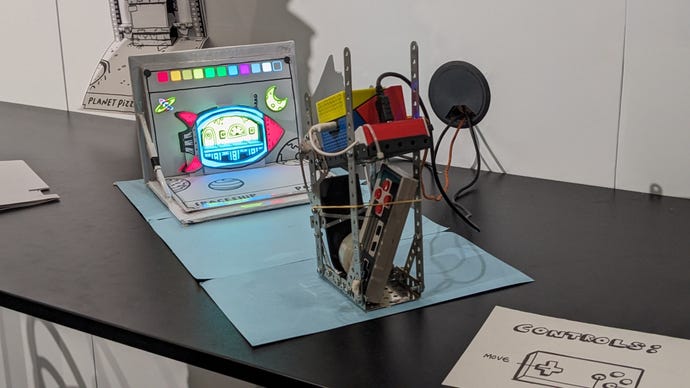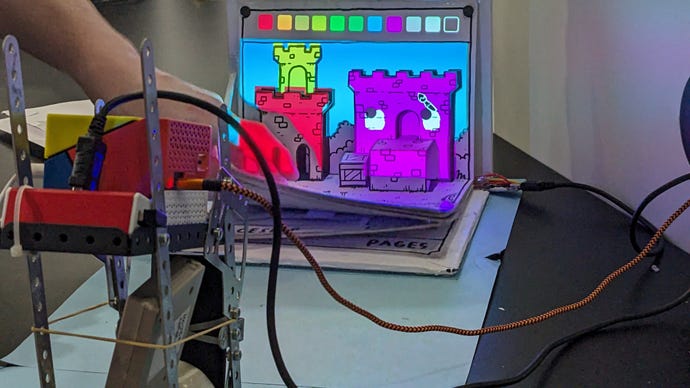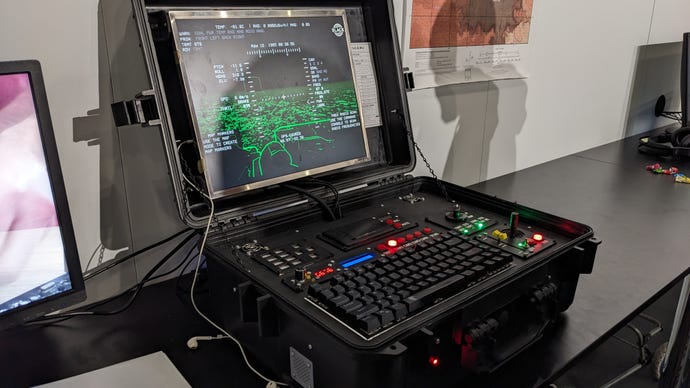[ad_1]
The Alt Controller showing at EGX this year was properly top tier stuff. There was, of course, the Future Of Play booth that our Graham organised for the show (the contents of which you can see right here), but every year the Leftfield Collection houses a couple more custom controller games that are just as illustrative of all the amazing things going on in the world of interactive entertainment these days.
Case in point, there were two games from this year’s cohort that impressed me in equal measure over the weekend – and it was perhaps fitting that they were located directly opposite one another in the Leftfield Collection’s long, white corridor. One was a mind-bogglingly complex, almost military-grade-looking briefcase stuffed full of switches, nozzles and buttons, and the other was an impossibly cute cardboard flip book and projector combo that let its cartoon hero Bib bound across the 3D paper environments to find a way home. Here’s a little look at both of them in action.




Let’s start with Bib, the star of Bib Goes Home. Technically, Bib Goes Home has three different games in one here – the platforming adventure starring yer boy Bib, a golf game that utilises the same, quite literal page furniture to create ready-made obstacle courses, and a colouring in painting game that lets you doodle/project colours onto the cardboard in real time.
They’re all equally delightful, but it’s the platformer that gives this device its name that’s really the star of the show. It’s quite simple fare as platformers go, mainly consisting of simple jumps, flipping switches and going in and out of doors (it was, after all, mostly made during a two-day game jam), but it’s so wonderfully executed that you can’t help but feel pure, unbridled joy from start to finish. There’s something quite magical about seeing a hero made from nothing but different coloured lights jumping around on real, physical cardboard as if it was some kind of 3D screen, and the way the projector illuminates the doors and portals and adds extra colour and decoration to each scene is truly lovely in the flesh.
One of the developers Alastair Low told me that the whole thing is programmed into the little Arduino chip that pokes out the end of the frame, and that there’s a small switch near the spine that acts as a kind of button press to activate the next page when you flip them back and forth. The projector, meanwhile, is encased in a block tower of Mechano and Lego, and the controller is an old (albeit wireless) NES pad. Low also mentioned he and his team were hopefully looking to try and mass produce Bib at some point in the future, to try and get it into as many people’s hands as possible. I truly hope they succeed in doing so, as I can see kids in particular going nuts for Bib and his adventure, and if part of it also involves building the tower Nintendo Labo-style, well… I think they’d be off to the races.

At the other end of the scale is Lost On Mars, a right old brute of a machine that not only comes with a complicated array of knobs, slider switches, buttons and a built-in keyboard, but also accompanying folders, maps and other bits of documentation that you’ve got to use in tandem to solve the mystery of a lost expedition crew. I’ll fully admit, it was difficult to try and figure out exactly what I was meant to be doing and where I was meant to be going in a crowded showfloor setting, but mucking around with the rover’s joystick controls and tootling about for a couple of minutes did look and feel pretty cool.
There’s a slider to control the speed, a separate brake switch to bring the rover to a halt, and buttons to switch between a camera view and the rover view. The camera let you take more detailed pictures of your surroundings than the black and green outlines on the main screen, and if I had more time, I would have liked to have sussed out exactly how to use it properly to progress a bit further. Alas, the developer Trey Ramm said a “full session” to find all the crew members would take around 90 minutes, 80 of which I didn’t have before I had to dash to another appointment (and whenever I came back to the Leftfield Collection, it was so swamped with other attendees that I never got a chance to try again). I’ll just have to be content with watching Ramm’s 15-odd minute gameplay video of it and absorb its cleverness that way (and it also provides a handy overview of all its constituent parts, too, in case you’re keen to find out more about how it all works together).


The Leftfield Collection was, of course, stuffed with lots of other great games this year, but these two (along with Hermit And Pig) were easily my personal highlights, so I hope you’ve enjoyed this small look at them from afar. To find out more about other games we liked from this year’s EGX, do check out our EGX London 2023 tag to see all of the team’s personal picks and favourites, and we’ll be back next year to root out more gems for you from the showfloor.
[ad_2]